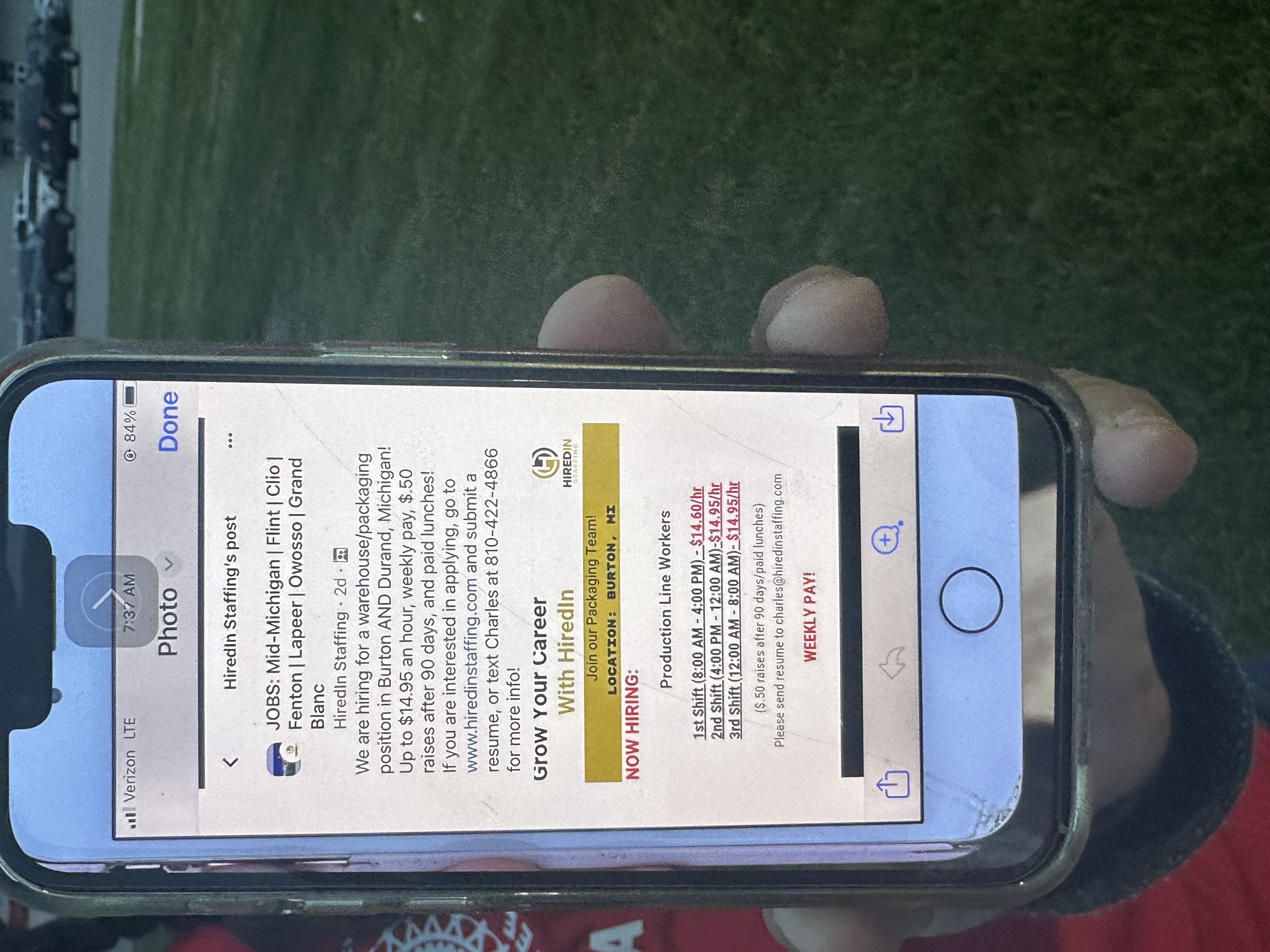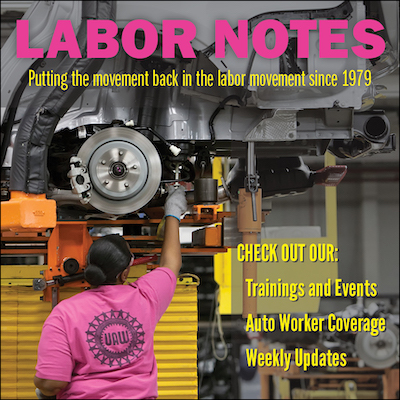Scabs Deployed at GM Parts Distribution Centers

Workers picketed at a General Motors parts distribution center in Swartz Creek, Michigan, this morning. The parts centers are hugely profitable for the automakers. GM appears to be bringing in salaried workers to staff these struck facilities, beginning tomorrow morning. Photo: Luis Feliz Leon
Auto workers at the Big 3 expanded their strike last Friday to a key vulnerability: parts distribution centers that supply dealerships with everything from water pumps to brake drums and spark plugs to replacement bumpers.
On Tuesday morning, General Motors began bringing in temps hired for $14 an hour to attempt to keep some of the parts and accessories flowing.
Parts distribution centers ship after-sales spare parts and accessories to car dealerships on a just-in-time basis. “If there is anything that could possibly break down that you need to get replaced, it probably came from a Customer Care and Aftersales (CCA) facility,” said strike captain Devon McKenzie on the picket line outside a GM parts facility in Burton, Michigan.
Five strikers were hit by a car leaving a GM parts center in Swartz Creek, Michigan, on Tuesday afternoon. Two were treated at the scene, local news reported, and three were taken to the hospital for treatment. Strikers said they believed the driver was a scab, but a General Motors spokesperson said the driver was a housekeeping worker who regularly cleans the facility and is employed by an outside agency.
'NORMAL DUTIES'
GM appeared to be planning to deploy scabs according to a text seen by Labor Notes a day earlier. “All salary employees should not report on Monday 9/25/23,” read the mass text from GM. “No one is to be on site except for security. All salary employees should be available by phone. All salary employees should report on Tuesday 9/26/23 at 7 AM. Please contact your leader if you have any questions.”
Workers believed this meant GM was asking salaried employees to show up the next day to staff the struck parts centers, just like it did during their last strike in 2019.
GM confirmed that salaried employees were reporting to work Tuesday, but said it was "to conduct their normal duties." The company did not mention that those duties would include supervising scabs doing the work of striking auto workers.
"We have contingency plans for various scenarios and are prepared to do what is best for our customers," the company told Labor Notes. "We are evaluating if and when to enact those plans.”

On the picket line at the CCA facility in Swartz Creek on Monday morning, workers had said they were ready to hold the line to prevent their supervisors from entering the plant.
In the 2019 strike, “from what we heard, they had brought salaried workers from other plants here to ship parts,” said a striker named Jim, who asked that only his first name be used.
“This time a lot of the assembly plants are still working, so the salaried workers are still preoccupied there. So I don’t know if they’re going to hire new people as scabs to do our work or if they’re going to try to use the salaried workers again.”
In 2019, the company sent the scabs into this plant through its truck gate. Picketers were able to prevent the scabs from entering for a while, until the company called in the police. After that, the police would let the pickets block each truck for about five minutes, then let it through.
On Tuesday morning, about 100 scabs were brought into the Burton facility.
Strikers on the picket line were skeptical about what the newly hired scabs will be able to do. “It takes a long time to learn our job, and the last time we went out it took us about six months to recuperate the work—we had to fix everything they did,” said Triska Alexander, who’s worked for GM in Burton for 17 years. “So I don’t know how successful they’ll be, and the amount of time that they’ll have—hopefully GM can come to an agreement.”
SPREADING STRIKE
Five thousand members of the Auto Workers (UAW) walked off the job last Friday at 38 parts distribution centers for Stellantis and GM across 20 states, joining 13,000 workers at assembly plants in Ohio, Michigan, and Missouri who had been out for a week.
Part distribution centers generally are much smaller than assembly plants, with workforces of 50 to 150 workers.
But at the million-square-foot CCA facility in Burton, the headcount is more than 1,200. Workers there process 9.9 million parts per month, filling orders for domestic and international customers. GM has invested $168.5 million in the facility, which opened in 2019, replacing an older building.
“We’re the cash cow,” said Local 651 member Roy Simmons. “And we ain’t getting milk. Where’s the milk money?”

SUPPORT LABOR NOTES
BECOME A MONTHLY DONOR
Give $10 a month or more and get our "Fight the Boss, Build the Union" T-shirt.
The facility is low-slung, a shiny mix of glass and concrete-gray; it looks similar to an Amazon fulfillment center. Sunday night, workers amassed at four gates walking in little circles as cars honked in support.
“We barely can make it but they got generational wealth,” Simmons said. “They got enough money for their kids’ kids’ kids to have money, but I’m struggling to just get my kid to college.”
“When 1,200 people are touching that many parts and sending them out to give the company a huge portion of their yearly profits, it only makes sense for us to go out [on strike],” said another Local 651 member, Jody Lorenz. “We’re making less than they do over in production facilities.”
Last Friday the UAW announced that GM had agreed in bargaining to eliminate the lower wage tier that CCA workers (and also GM Components Holdings workers) were placed on in earlier rounds of concessions. They will be on the same wage scale as assembly workers going forward.
“We’ve got people that were making $16 an hour in our plant,” said Barney Hennessy, a strike captain at the Swartz Creek parts depot, who has worked there 38 years. “You can go to Target or McDonald’s and make more money than that. It’s hard to get people to stay in our plants because they're not making a lot of money. All we’re trying to do is bring everybody up to the same amount of wages, so everybody can enjoy the kind of living that we used to enjoy before inflation.”
At Swartz Creek, workers say GM has brought in a new, non-union trucking company, Universal, to transfer trucks from inside the plant to outside the plant, after Teamster truck drivers refused to cross the picket line. "Probably by tomorrow we'll have non-[union] semi drivers hauling the stuff away," said a Local 651 member.
COLD WAR
Brian Schneck is president of UAW Local 259, which represents members who work at 23 GM and Stellantis dealerships. He expects that dealerships will start to feel the impact of the strike next week, as stockpiled parts run low.
Car dealerships, he points out, are the Big 3’s real customer base—since the public doesn’t buy directly from the automakers.
“The dealers need to be outspoken,” Schneck said. “They should go public and say to the vehicle manufacturers, ‘You guys got the f***ing money. Settle, do the right thing, so we are then empowered to service our customers the way that they should be. Because you guys want to be arrogant, you guys want to continue to drive down wages and you want it all for yourselves, you are causing us extreme pain which in turn is causing pain to our customers.’
“The dealers should be freaking going bananas on the manufacturers,” he said. “But they won’t, because they’re afraid of them, because they always want to have their cushy relationship. That way they get the right allotment of cars. There’s a lot of stuff the vehicle manufacturers do to deliberately punish the dealerships. It’s this cold war that’s been going on for a long time.”
STOCKED UP
Management started stockpiling parts weeks before the strike deadline, according to workers in Swartz Creek and Burton. Workers did overtime and managers got trained in driving forklifts.
“I just wish I could be a fly on the wall to see my manager run my machine,” said Kim, who works at the Burton facility; she asked to only use her first name, fearful of management reprisals when she returns to work.
She operates a machine that bags up the specific parts requested by a dealership; she checks the quantity and country of origin to make sure everything is correct. These small details are important.
“When an employee processes parts, we each have what we call a stamp number, and it’s a stamp with an individual number,” Kim said. “So anytime a part is processed wrong in the plant, they can trace it back to the person that did it.”
Management, on the other hand, doesn’t have to worry about being dinged for mistakes, she said: “When managers run anything in there, they put in all zeros. So there’s no accountability whatsoever.”
During the 40-day strike in 2019, GM brought in salaried workers from other plants to keep operations going. “The supervisors and management were in there trying to do our job, which was unload the trucks, do the processing, and ship the parts out,” said Simmons.
After the strike, workers spent months fixing quality control issues, because management had shipped parts to the wrong location or mislabeled parts with the wrong station code. “We were fixing parts over six months because they f***ed up everything they touched,” Kim said.
What will workers do when the salaried employees show up on Tuesday? “Wish them luck,” Kim said. “They’re gonna be so goddamn lost.”
This article has been updated with a response from GM, to reflect the company bringing in newly hired temps, and to include the vehicle hitting five picketers with a car. Last updated 9:16 p.m. ET September 26.







